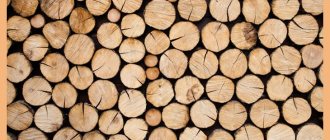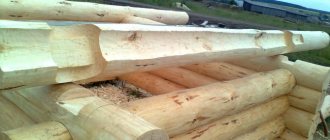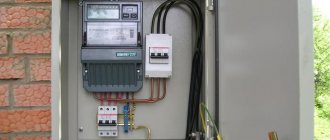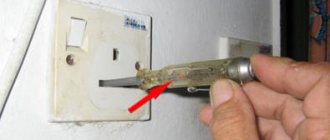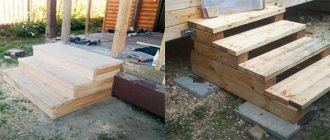Real estate
00:00, 01/04/2021 6 Plot: House in focus
Metal spoon, iodine and other tricks
Photo: stroim-35.ru
Despite the obvious advantages of laminated veneer lumber and other types of “modified” wood, many still prefer regular round logs when building a house. Even more often, a log house is chosen for building a bathhouse. A reasonable approach is to buy not individual logs, but the entire log house. This is a good way to save time and maintain at least some order on the construction site. Today we’ll talk about the basic principles and approaches to choosing a log house.
Two hundred and one defect
When choosing a log house, the main thing is to make sure that it is made of suitable material, because, of course, logs are different from logs. To begin with, you can arm yourself with knowledge about visible defects in logs, which number not even in tens, but in hundreds.
Even a seemingly ordinary knot (when a branch grows into the body of a log, and when cut, a characteristic round pattern is obtained) has 27 varieties. Visible wood defects are described in a separate document - an interstate standard, which is based on several GOSTs. This is a very fascinating read: in addition to 27 types of knots, here you can get acquainted with 17 types of cracks, 57 types of trunk defects, 5 types of chemical stains (including those resulting from drying), 23 types of fungal infections and rot, 11 types of biological damage (including wormholes and damage caused by birds), 34 types of mechanical damage to wood and 7 types of warping.
And then this interesting document describes in detail how all these defects are measured and how to properly classify them. There are also detailed drawings from which you can learn to distinguish wood defects. Separate chapters are devoted to round timber (this is what interests us when choosing a log house), veneer and lumber (these chapters will also definitely come in handy a little later, when you start finishing and deal with interfloor ceilings and other “wooden” construction work).
Photo: sekretymastera.ru
A humorous warning: if you are planning to build a wooden house, then you should read this standard in detail only if you have strong nerves - so that it doesn’t turn out like Jerome Klapka’s hero Jerome, who read a medical encyclopedia and, as a result, found everything described in it. diseases other than puerperal fever. However, it also contains reassuring information: not all types of visible wood defects affect its performance properties. Many of the two hundred defects described affect only the outside, in appearance.
Floor, ceiling and partitions after 6 months of shrinkage
In the closed circuit of the house, you can already begin lining the ceilings and laying the floor (at least the rough one). If the project provides for additional partitions, frames for them are usually erected directly on the subfloor.
When the internal volumes are obtained and all rooms are demarcated, the location and dimensions of interior and interfloor openings are specified. At the same time, ventilation shafts are erected, stoves and fireplaces, and chimneys are installed.
If the house was initially covered with a temporary roof for shrinkage, after this stage of construction of a private house, you can begin to finish the roof and equip the roof with snow retainers and a drainage system.
Marking - according to GOST
The main document that you should familiarize yourself with before choosing a log house today is GOST 2292-88 - “Round timber. Labeling, sorting, transportation, measurement methods and acceptance.” GOST 32594-2013, which describes measurement methods, is also useful (for example, there is an interesting table here that describes in detail how much wood in cubic meters is contained in lumber of a given thickness and length).
Photo: blog.marisrub.ru
Logs in a log house must be marked (each log, according to GOST, must be marked if the diameter of the log is more than 14 cm and the length is more than 2 meters). The marking is applied to the upper end of the log using a durable material (waterproof paint or special crayons). The main thing is that the label reaches the consumer in a legible state. The size of the marking should be at least 3-5 cm.
The marking must necessarily contain the following information: grade (from first to fourth, indicated by Roman or Arabic numerals) and thickness. Thickness is indicated in a more cunning way: in Arabic numerals, using the last digit of the thickness number:
- if the log thickness is 20, 30, 40, 50 cm and so on, the thickness marking will be 0;
- if the thickness is 22, 32, 42, 52, etc. — thickness is marked with the Arabic numeral 2;
- if the thickness is 14, 24, 34, etc. — GOST requires marking 4;
- Markings 6 and 8 are applied in similar cases.
GOST, which regulates the acceptance of lumber, describes the features of their acceptance. But in our case, if we choose a ready-made log house, its manufacturer is responsible for acceptance. However, it will also be useful for you to familiarize yourself with this section.
Prices for dismantling
The cost of dismantling low-rise buildings depends on several factors:
- Dimensions and number of floors. The larger the geometric parameters (length/width/height) of the building, the longer and more expensive it will be to carefully demolish the building. The number of floors (from 1 to 3-4) determines how many interfloor partitions specialists will have to dismantle;
- Type of materials used for the construction of load-bearing architectural elements - walls, ceilings, roofs. A wooden frame can be relatively easily and quickly disassembled by hand with minimal use of tools and equipment. Demolition of stone, brick, block or monolithic elements of frame houses will require the use of jackhammers or construction equipment with attachments - a hydraulic hammer for dismantling;
- The use of expensive special equipment to destroy particularly strong elements of a house - a monolithic or strip foundation;
- Ordering additional services. Companies specializing in the dismantling of houses, at the request of the customer, collect and remove construction waste, store the remaining building materials for reuse or sale.
Summer and winter wood: there is a difference!
Since ancient times, builders have seen and used the enormous difference between the quality of wood harvested at different times of the year.
Photo: nedvio.com
Winter wood is the material that most experts recommend. This is timber that is harvested in winter. It has greater physical durability and much higher performance and quality. Winter wood does not warp, shrinks evenly during the drying process, and the moisture is frozen out of it. In winter, excess resin comes out of the tree and even insects crawl away. A house made of such wood will last at least a century.
True, the calendar month of harvesting itself is not a 100% guarantee of the quality of the timber: it is important that it is left to rest in a well-ventilated warehouse for about a month before transportation and processing. It is also important not to keep such a log house in storage.
Summer wood is usually of worse quality. Most likely, a summer log is very wet, and for its quality harvesting it is necessary that the manufacturer dry it well, and most importantly, evenly. Summer wood should be treated with an anti-mold compound and insecticides (because in the summer there is a real riot of various living creatures inside the tree).
Closing the outline
After completion of the main, most significant shrinkage, you can begin to close the outer contour. This stage of building a log house consists of the following substages:
- cladding and insulation of the foundation, installation of vents (ventilation holes) in it;
- arrangement and insulation of the blind area around the foundation;
- insulation of the log house (caulking, insulation of inter-crown spaces);
- arrangement of window and door openings, installation of windows and entrance doors;
- external roof lining, roof insulation, floor insulation, attic ventilation device, engineering wiring
Why is chopped log better than other building materials?
To talk about the pros and cons of a debarked log, it is necessary to indicate what to compare it with.
For example, if we are talking about a rounded log, which is often opposed to a chopped one, then
the advantages of debarking are as follows:
- cutting is stronger and more durable due to the preservation of sapwood - the hardest part of the log;
- felling is less susceptible to rotting, again due to the preservation of the outer layer;
- chopped logs can reach a diameter of up to 30-40 cm, which is important for construction in northern latitudes.
Disadvantages of debarking before profiled or rounded logs:
- an untreated log has a higher percentage of moisture, and it will take quite a bit of time to dry;
- during construction you have to cut out the grooves and locks yourself;
- cutting requires lengthy sanding of the top layer before painting.
Now let's look at the advantages of logs over bricks or cinder blocks:
- Low thermal conductivity, ensuring long-term heat retention in the room.
- High environmental performance, it does not emit resins or dangerous chemicals.
- Saving foundation costs due to the light weight of the structure.
- A cube of logs is cheaper than a brick or cinder block.
Everyone knows the disadvantages of logs. In general, wood is not preferred because:
- It burns well even when treated with fire retardants.
- Susceptible to rotting, mold, mildew, and insects.
- It requires constant maintenance; the walls must be treated and painted every 5 years.
All of the listed disadvantages to stone buildings arise only if the log falls into the wrong hands. With the right approach and technology, you can build a warm, beautiful house that will become a family nest.
How to choose the right wooden material?
First you need to decide what kind of house it will be, winter or summer. For a warm room, it is advisable to choose a material with a large diameter , starting from 25 cm. The thermal performance is also affected by the number of crown seams.
That is, the more there are, the greater the likelihood of heat leaks. In other words, the more crowns and logs there are along the height of the house, the worse it will be. Therefore, you need to choose thick logs so that construction costs are less.
The degree of drying of the log matters. Since chopped logs do not undergo chamber drying, their humidity can reach 50% or higher. It will take more time for shrinkage and natural drying in the fresh air. It is rational to buy a log with a moisture content of no more than 25%.
If it is possible to examine a product before purchasing, it is necessary to take into account its external characteristics. The material should be rejected or sent back to the manufacturer if:
- There are a lot of cut branches on it. They dry out first, forming cracks or falling out completely.
- There is a blue tint to the lumber. This is a fungus that cannot be removed. It does not affect the strength of the log, but it will have to be bleached regularly.
- The log has large longitudinal cracks, the thickness of which reaches 3-5 cm. After drying, the cracks will grow through.
- There are insect marks, holes or tunnels on the surface.
The log should not crumble in any places; this is an indicator of rot, which also affects the entire surface of the tree over time.
Communications layout
Before starting interior decoration, all the necessary communications are installed throughout the house: boiler rooms and boiler rooms are installed, electricity is drawn, heating, water supply, and sewerage are provided.
Only end-user equipment that can be damaged during repair work is left for the finishing stage - lamps, switches, sockets, radiators.
